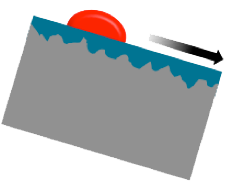All solid surfaces, even non-stick or smooth ones, are inherently rough on a microscopic level, creating many points that pin a fluid to the surface and cause it to smear.
SLIPS™ surfaces feature a stable, immobilized liquid lubricant over-layer. Unlike solid surfaces, this liquid surface is truly smooth and extremely slippery. Fluids and biological fouling agents have nothing to hold on to and slide right off.











